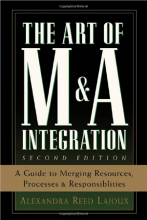Fundamentals of M&A: An Excerpt from The Art of M&A Book Series
By Alexandra Reed Lajoux, Board of M&A Standards/Founding Principal at CapEx

How Common are Postmerger Divestitures of Acquired Company Units?
It depends on how long a timeline for divestiture you are considering. Few companies divest units immediately following an acquisition (unless they are compelled to do so by antitrust regulators), but many companies divest them eventually. This process is very hard to trace over a significant period of time, since companies and their units are always undergoing restructuring and renaming.
In any given year, nearly half of the acquisitions that occur come about because the sellers are divesting a company unit. Given the fact that most major companies grow both externally and internally, it would be reasonable to assume that about half of these divestitures stemmed from acquisitions, as opposed to internal growth. According to this logic, we would conclude that, over time, about one-fourth of all acquisitions are eventually divested. Yet in major companies, the level appears to be lower. In a follow-up study for the 10 largest mergers of 1985, the author of this book found that only a minority of the deals had ended in a divestiture even after 20 years – and most of the divestitures were partial.
What kinds of divestitures are there?
There are three basic types of divestitures: sell-offs, spin-offs and split-ups. Some of these may involve a continuing involvement – a strategy referred to as a satellite launch.
What is a sell-off?
A sell-off, which is by far the most common type of divestiture (and the type usually referred to as such), is the sale of one or more company units to another company – for example, when BF Goodrich Corporation sold its JcAIR Test Systems business to Aeroflex Incorporated in 2005.
What is a spin-off?
A spin-off is a series of transactions through which a company divests or “spins off” one or more units – typically a small portion of its business with some common theme – by turning them into an independent company and selling the company’s shares to the investing public. Recent U.S. examples include Sara Lee Corp.’s spin-off of its apparel business (as Sara Lee Branded Apparel Americas / Asia) in 2005 and the spin-offs of Abbott Laboratories’ hospital products division (as Hospira) and General Electric’s insurance businesses (as Genworth) in 2004.
Sometimes spin-offs precede mergers. For example, in Switzerland, Sandoz and Ciba spun off their chemicals business units – one as a taxable initial public offering and one as a tax-free “demerger” – before merging their pharmaceutical cores into Novartis. The slimmed-down Ciba, renamed Ciba Specialty Chemicals, then grew through acquisition. For example, it bought the Korean company Daihan Swiss, completing the acquisition in November 2004.
Spun-off units may be sold separately through separate spin-offs or may be combined into a single spin-off. This process usually begins with a pro rata distribution of stock to shareholders in the form of a special dividend, followed by (or combined with) an initial public offering of the unit’s shares. A common type of spin-off is the “IPO carve-out,” in which the company goes straight to the IPO without the distributions to stockholders. If the parent retains an interest in an IPO carve-out, this may be termed a “divestiture IPO.”
What is a split-up?
A split-up is the breakup of a company into two or more separate companies. It is different from a sell-off or a spin-off in that it involves the entire company, not just a unit or two. The most famous split-ups have involved AT&T. In 1984, AT&T broke up under order from the Department of Justice Antitrust Division, dividing into a telecommunications company (today’s AT&T) and regional Bell operating companies (a.k.a. “baby Bells”) to handle local calls. Then in 1996, having grown through acquisition, AT&T divided itself again – this time voluntarily – citing business complexities that outweighed the benefits of integration. One of the surviving units, interestingly, followed this split-up with the spin-off of a unit, Lucent Technologies, in 1996, while another unit, AT&T Wireless, after being spun off in 2001, merged into Cingular in 2005.
What usually motivates postmerger divestitures?
Reasons for divestitures vary. A unit may be sold or spun off, or a company may be split up, because it is performing poorly and the seller wants to stem the tide of losses. Conversely, it may be sold as a “crown jewel” because it can fetch a good price. Finally, and least appealingly, it may be tagged for sale to appease regulators – for example, the Antitrust Division of the Department of Justice or the European Union – which may set this as a condition for regulatory approval of a merger. For example, Procter & Gamble had to sell its Crest SpinBrush toothbrush business in order to win European Union antitrust approval to buy Gillette in 2005.
Interested in learning more about divestures and carve-outs? Registration is now open for our November 2022 Live-Online training - The Art of M&A® for Divestitures & Carve-outs - sign up today!
_______________________________________________________________________________________
Lajoux, Alexandra Reed. “M&A Integration Applying to Acquisitions of Partial Interests” The Art of M&A Integration: A Guide to Merging Resources, Processes & Responsibilities. United States of America: McGraw Hill, 2006. Pp. 21-24. Print.
For a complete list of references/notes within this article please call the M&A Leadership Council at (866) 394-3690.